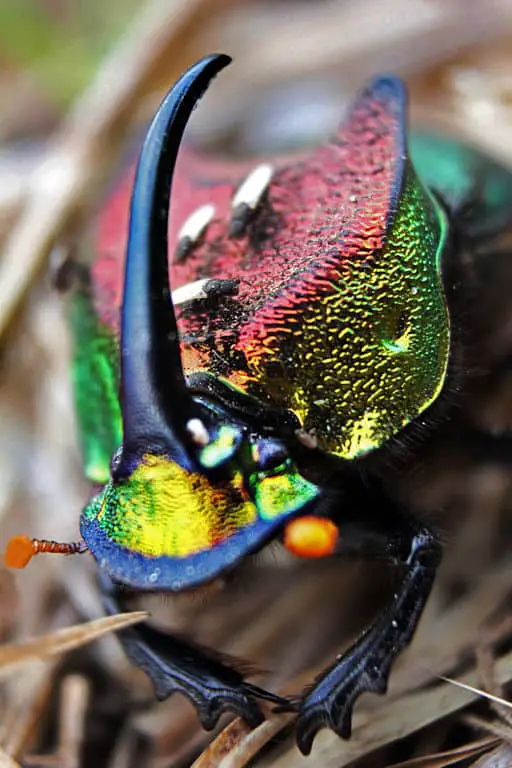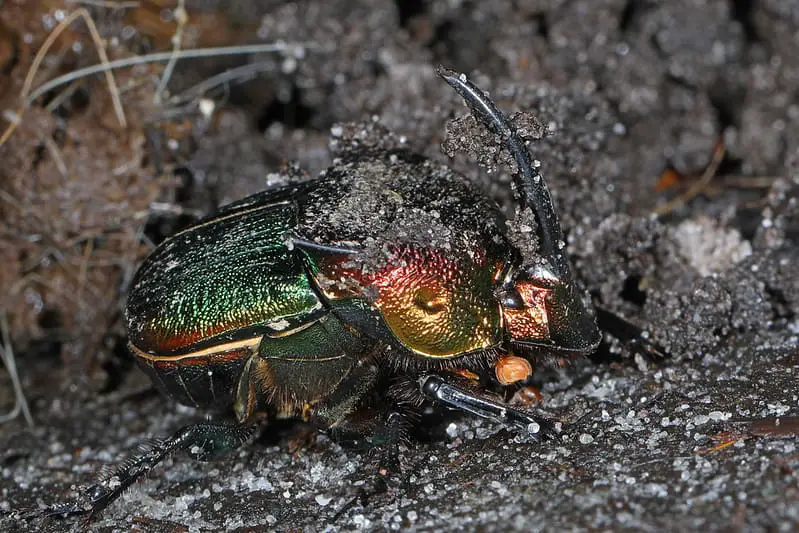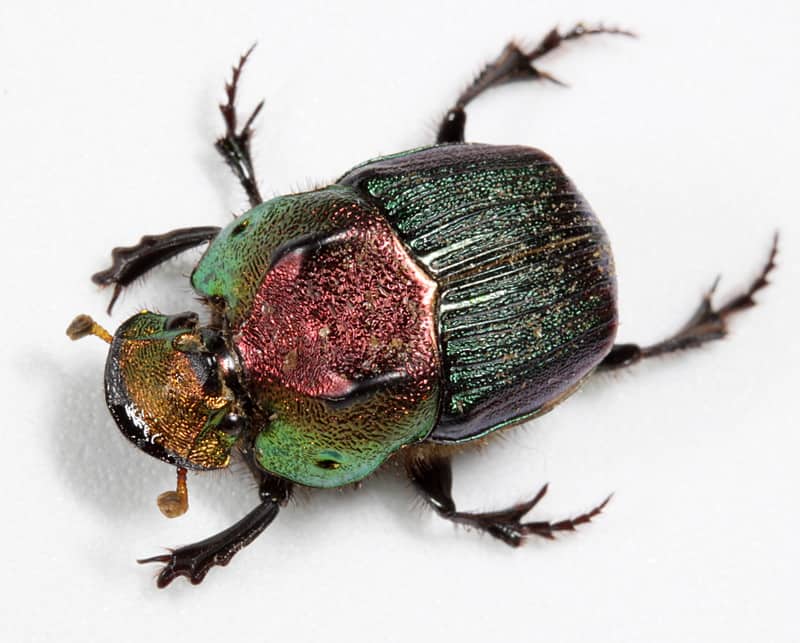The Rainbow Dung Beetle or Rainbow Scarab is a very unique beetle species. Unlike other dung beetles, the RDB displays bright and beautiful colors that make it a popular choice among hobbyists.
It’s also very safe to handle and care for. It often chooses to play dead when it feels threatened instead of attacking; hence, it’s a great choice for a pet. If you’re thinking about getting one of these amazing insects, we’ve gathered all the information you need to see if it’s the best fit for you and how you can properly care for them.

Rainbow Dung Beetle Care Sheet
| Name of species | Phanaeus vindex |
| Family | Scarabaeidae |
| Common name | Rainbow Dung Beetle, Rainbow Scarab |
| Category | Beetle |
| Type | Scarab Beetle, Dung Beetle |
| Native location | The United States and Mexico |
| Size | ½ to ⅞ inches long |
| Diet | Animal dung and compost |
| Lifespan | 6 to 18 Months |
| Experience level | Beginner |
Rainbow Dung Beetle Overview

The Phanaeus vindex gets the name of Rainbow Dung Beetle or Rainbow Scarab. This beetle is a paracoprid, which means it’s a burrower that spends most of its time underground. Known for its beautiful colors, the RDB can be found in open pastures all through the eastern side of the USA and northern Mexico. It feeds on dung, but it can also eat sweet fruit or beetle jelly in captivity.
Appearance and variants
Rainbow Dung Beetles have an oval and bulky body covered with bright and metallic colors. The most common appearance is a yellow head, red-bronze pronotum, and green elytra.
However, males sometimes have a darker-blue color, just like their horns. The rest of their body is usually bronze, and sometimes they show their adorable poofy antennas at both sides of their heads.
Rainbow Scarabs have sexual dimorphism, so males and females look different. It’s often easy to tell them apart since males have a long curved horn coming out from their heads, but this doesn’t always happen.
There are also minor males, and they either have tiny horns or no horns at all; this makes it harder to sex an RDB. However, if you look carefully at the pronotum, you’ll know whether it’s a male or a female.
A male’s pronotum is long at both ends, slightly covering the elytra for additional protection; this doesn’t happen with females.
Price
The Rainbow Scarab is a very common beetle. It’s also easy to breed and care for, so it’s not an expensive pet.
Depending on where you get it, you’ll find adult specimens at prices ranging from $9 to $15. Usually, stores don’t let you choose the kind of beetle, and major male beetles are rare, so you should get many RDBs at once to make sure you get females, minor males, and major males.
Behavior and Temperament
The Rainbow Dung Beetle is a harmless and peaceful insect. It plays scared when it doesn’t want to be bothered, so don’t be scared if it suddenly goes limb while you handle them.
You don’t have to be worried about being bitten by one of these beetles, which comes as a relief considering their diet.
They’ll choose to fly away or play dead if they feel threatened, so it’s safe to handle them as long as you’re careful not to let them fly away.
They’re not venomous, poisonous, or defensive, so they’re very safe to handle, even for kids.
Caring for a Rainbow Dung Beetle

Temperature and Humidity
The Rainbow Dung Beetle lives in North American pastures in high temperatures and medium to low humidity.
It’s best to house them in temperatures of 70°F to 77°F and 40% to 60% humidity. Also, keep the tank away from sunlight to keep the RDB comfortable and prevent foul smells from their food.
Substrate
Rainbow Dung Beetles need to burrow deep, especially when trying to breed. Therefore, the enclosure should have at least six to eight inches of substrate.
As for substrate composition, a mixture of organic compost, soil, sand, and coconut fiber work best for them.
Tank
Rainbow Scarabs don’t need large tanks to be comfortable. You can house several RDBs together in the same tank as long as there’s enough place for the substrate, it has good ventilation that doesn’t allow the beetles to leave the tank, and there’s a safety lock in the tank lid.
The substrate can occupy most of the tank’s space since they don’t spend too much time at the surface; this also means that decorations are good but not necessary.
Watering
Rainbow Dung Beetles get their hydration from their food and the environment, so there’s no need to place a water dish inside the enclosure.
Mist the substrate to keep it moist but not wet. You’ll know the moisture is right by pressing it between your fingers; it must be wet enough to maintain the shape but dry enough so that it doesn’t drip liquid.
Diet of a Rainbow Dung Beetle
As the name implies, Rainbow Dung Beetles feed mainly on dung in the wild. You may give them rotten fruit or beetle jelly if you don’t feel comfortable handling dung. However, it’s the cheapest option for the RDB’s nutrition; it’s also perfectly acceptable, so don’t keep yourself from using it.
You can buy dry dung, but using it from other pets such as rabbits is possible too. Cow manure is the best food for RDB grubs.
You can avoid feeding dung to adult RDBs, but they’ll need access to it if you want them to breed. The RDB rolls balls of dung and dirt into their burrows, where they’ll place the eggs and provide more of these balls to their offspring for future nourishment. Cow dung works best for this purpose, but make sure to drop small portions of this to make it easier to clean.
Fun Facts about the Rainbow Dung Beetle
- Human infestation of dung beetles is very uncommon but not impossible. Accidentally ingesting the larvae is the most common cause, so it’s easy to avoid it in controlled environments. There have also been cases where the RDBs fly into someone’s ear and harm it with their legs. However, there’s no real risk of this happening as long as you’re careful not to let any fly away.
- Dung beetles are important in nature to control the accumulation of fecal waste. A relevant historical example happened in Australia when they introduced ruminants for farming. The country experienced an accumulation of dung, so they had to introduce these beetles to the ecosystem. The solution worked, and the beetles became part of the natural balance of Australia.
- The horn fly, as well as other harmful fly species, compete with the Rainbow Dung Beetle in the same habitat. RDBs have a tendency to win these competitions, so having these beautiful insects on a farm is beneficial.
- A neat trick for plant lovers is to recycle the enclosure’s substrate with your plants. You should change the RDBs substrate every couple of months to prevent it from accumulating fungi. This is a great opportunity to plant something with fresh soil since the old substrate will be highly enriched with nutrients.
Final words: Is the Rainbow Scarab Right for you?
Rainbow Dung Beetles are a welcome sight. Beautiful and harmless, they make great beginner pets and safe companions for kids; they’re also great for farms since they improve the soil’s quality by integrating the cattle’s manure into it.
However, these beetles are not right for everyone. Their diet is offputting for many people. If this is the case for you, check out some other species such as the Atlas, Japanese Rhinoceros, or Rainbow Stag Beetle instead.
- How Long Do American Eskimo Dogs Live? Important Factors and Care Tips - September 29, 2023
- Do American Bulldogs Need Grooming? Essential Tips and Care Guidelines - September 29, 2023
- Do Bengal Cats Enjoy Playing? Essential Tips for Keeping Them Active - September 29, 2023